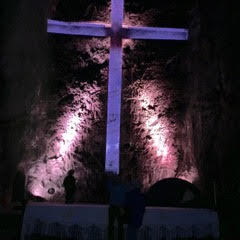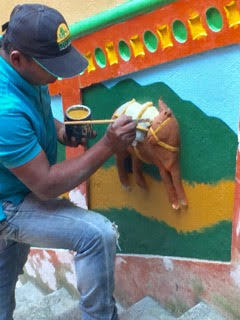In the months before I went to Colombia on tour, I was reading a book called Salt. Did you know that salt was the most precious commodity since almost the existence of mankind? Salt linked every city, every country, and every tribe for thousands of years before the birth of Christ and thousands of years after. Salt still carries the cache of being the most valued commodity in the world.
So I was thrilled to visit a salt mine in Colombia known as Zipaquira Salt Cathedral in the mountains north of Bogota, a fascinating religious site. This unique cathedral is built into the tunnels of a salt mine, stretching more than 600 feet underground, with statues and ornaments carved out of the mine’s rock walls. The complex features an entryway lined with 14 small chapels that depict the Stations of the Cross and is considered a highlight of Colombian architecture. The experience was otherworldly and truly one of the most incredible wonders of the world.
Colombia was one of the original Spanish outposts in the mid-16th Century. When the Spanish found gold, they thought they found nirvana. They called it El Dorado. As a testament to Colombia’s riches, more than 6,000 pre-Hispanic gold artifacts are on display in Bogota’s Gold Museum. These precious pieces of gold showed us a window into Colombia’s indigenous cultures spread out over 439,733 square miles, the 5th largest country in South America.
Medellin’s reputation of a city of violence preceded our visit. Because our tour guide, Paulo, was born in Medellin and knew its history as well as its soul intimately, he became our window to its recent violent history and a chronicler to its modern rise as a unique tourist attraction.
But that was then, in the 1980s and 90s, and today Medellin is a vibrant, modern and exciting city. Seven hills surround the city made easy to access with a modern aerial tram. The panoramic views and its warm and embracing people make this city another jewel in the fabric of Colombia. We even made a home visit with Dona Alicia to listen to the anecdotal experience of what it’s like to be born and live an entire life in those amazingly rich hills.
Even though Medellin is undergoing an economic and cultural rebirth, we, of course, retraced the steps of the most infamous resident that Medellin produced, Pablo Escobar, the most notorious drug lord of the 1980s. Paulo fled Medellin with his parents when he was 7, but as Paulo recounts it, Escobar’s story is as immediate and chilling as it was during the time of chaotic violence.
We traveled to Guatape, a colorful village in the countryside outside Medellin known for its crafted tiles and decorated houses, and then on to El Penon, a monolithic rock that rises more than 650 feet above its surroundings that overlooks a nearby dam. Guatape was the site of large-scale conflicts between the government and paramilitary forces in the late 20th century.
After weaving our way through Medellin’s open-air collection of 23 sculptures by Fernando Botero and exploring the Antioquia Museum, which traces the history of Colombia, we flew to Pereira to stay at a traditional hacienda (we were the only guests in residence at Hacienda Castilla), one of the three towns that comprise Colombia’s coffee triangle. Colombia coffee-making is a tradition that is known worldwide, and we were royally treated to the inner workings of a how coffee is lovingly made by an attorney turned coffee entrepreneur, Jesus Martin. He makes espresso beans like you’ve never tasted in your life.
Yet the Periera area is comprised of more than just coffee: we visited a ranch that raises Colombian Creole horses and some of us got to sit the saddle and ride with the most beautiful trotting horses in the world. Forget Tennessee Walkers; the Creole’s trot is strength and beauty at its finest.
The local cuisine in this coffee region is another sensory treat. All produce and vegetables are organic and sweet tasting. The corn is a standout. We were also treated to a cooking lesson in Manizales and now we can all make the most delicious fried plantains. The most interesting aspect of growing crops from coffee to fruits and vegetables is that these activities are seasonal and tendered with loving care in fertile land all year round.
Our final turn in the coffee triangle was the region around Armenia, once a way station on the march of Simon Bolivar, one of the most famous South American liberators. We frequented the coffee shops in the Cocora Valley, and then traveled in yipaos, colorfully decorated Jeeps, and took a three-mile hike to 8900 feet in altitude into the cloud forest. We learned about the wax palm, the national tree, which can grow to a staggering 250 feet, and then had the privilege of participating in planting a small wax-palm, a ritual meant to replenish the natural beauty of the valley and honor the local Quimbayas people.
Our final destination was the coastal city of Cartagena, a tropical location whose riches were the target of pirates from Spain, Britain and France. Spain was so covetous and protective of this coastal city that they built their own fortifications, large portions of which have survived today (Ciudad Amarullada). Exploring the 17th century San Felipe Castle with its labyrinthine tunnels that run beneath the ground and its panoramic views was exciting and breathtaking.
Cartagena has changed over the last 20 years; in fact, its coastline is beginning to resemble Miami Beach. The city is expanding and growing in the areas of fine dining, shops, beaches and hotels. It is becoming a sophisticated city where emerald workshops seem to reflect the new glow of a city that was once a sleepy port.
My strongest and most memorable memory of my Colombian tour was the last home visit we had with a family who lived in a poorer section of Cartagena – a family who believed in strong educational values and whose 6 children each excelled in speaking English and working in mainstream jobs. The titular head was named Alex, an English teacher by trade (his oldest son is also an English teacher), but who donates his time teaching English to a free community center. He also coaches baseball and takes pride in the successes of those who are determined to contribute to their community. Alex is truly the soul of Cartagena.
Travel transforms, enlightens and astonishes. Colombia, the jewel of South America gave me all those experiences and more. The people, the landscape, the rich cultural heritage and its natural resources gave me a deeper perspective into a country once torn apart by violence but now replenished with vitality and vision.

